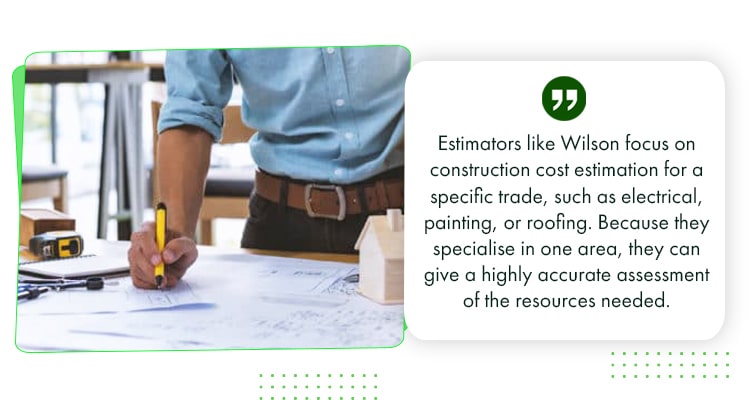Remote work was once limited to finance and IT jobs, but today, opportunities have expanded—even into the construction industry, which typically involves onsite work.
Over the past decade, remote estimators have joined architects, civil engineers, and construction workers in building structures around the world.
One of them is Filipino engineer Wilson Petaluna.
Meet Wilson Petaluna: A Remote Estimator’s Journey
Wilson Petaluna knows what it takes to be an estimator in Australia—while working remotely from the Philippines.
Before becoming a remote estimator, Wilson earned a degree in civil engineering. Like many fresh graduates, he began as a project engineer, working on various building projects in the Philippines.
He later moved to the United Arab Emirates (UAE), where he worked as a quantity surveyor, managing cost estimates involving different trades, such as:
- Architectural
- Structural
- Electrical
- Plumbing
- Mechanical
Eventually, he returned to the Philippines, but his work with international companies is far from over. He now specializes in roofing estimation for an Australian company, continuing to share his expertise from home. And he is not the only one.

Like Wilson, thousands of Filipino professionals in the Philippines are delivering their world-class skills to clients worldwide, particularly in the field of remote estimation.
What Does an Estimator Do?
An online estimator acts as a financial forecaster, bringing blueprints and technical documents to life by providing accurate cost projections.
Their key responsibilities include:
- Project Analysis – Estimators check the project specifications which outline quality standards, installation methods, and specific products, allowing them to understand project requirements.
- Research and Pricing – They research and gather quotes for materials, labor rates, equipment costs, and subcontractor bids. They also stay updated on market trends and price fluctuations.
- Bid and Proposals – Estimators also compile all relevant information to create a comprehensive bid that outlines estimated costs, total project cost, and timelines.
- Risk Assessment – They identify and assess potential risks that could impact project costs, such as material price increases, labor shortages, or unforeseen site conditions.
- Procurement Support – In some cases, estimators can help the procurement team negotiate prices with suppliers and subcontractors.
For instance, Wilson specialises in roofing estimation, providing initial costings based on the roof’s dimensions, slope, type, and features like skylights, vents, or chimneys.
With 10 years of experience in the Philippines and abroad, he understands the labor needed for various roofing tasks. His engineering background also allows him to suggest cost-saving materials or methods without compromising their quality or results.
Quantity Surveyor vs. Estimator vs. Cost Engineer: What’s the Difference?
Wilson began his career as an engineer, then worked as a quantity surveyor, and now works as an estimator. While each role requires different skills, they also share some similarities. Let’s take a closer look:
Estimator
Estimators like Wilson focus on construction cost estimation for a specific trade, such as electrical, painting, or roofing. Because they specialise in one area, they can give a highly accurate assessment of the resources needed.

Using project drawings and specifications, they calculate quantities and costs, especially during the pre-construction phase. Their work is key to the construction bidding process, as accurate and competitive estimates help contractors prepare proposals for clients.
Once the bid is submitted and the project is awarded, they usually step back from daily construction activities, unless clarifications or assistance are needed.
Quantity Surveyor
Before becoming an online estimator for AU clients, Wilson worked as a quantity surveyor in the UAE, where he managed all aspects of a project, not just roofing.
Unlike estimators who focus on pre-construction, quantity surveyors (QS) handle costs from the start of the project through to its completion, including:
- Preparing initial cost estimates;
- Managing budgets and expenses during construction;
- Handling contract administration;
- Assessing variations and changes in scope;
- Ensuring value for money throughout the project; and
- Preparing final accounts after project completion.
Cost Engineer
Meanwhile, cost engineers make sure the project stays within the approved budget. Their responsibilities include:
- Tracking actual costs against the planned budget;
- Analysing any deviations or variances; and
- Monitoring labor costs, material expenses, and equipment use.
Consequently, they keep detailed financial records throughout the project to track all costs, changes, and approvals.
After the project ends, they assist with final cost conciliation, review the project’s financial performance, and identify areas to improve future projects.
Unique Features of Australian Online Estimation
Unlike the UAE, which prefers quantity surveyors to handle all aspects, Australia prefers estimators to focus on one trade.
In other words, an estimator has the option to specialize in roofing, concrete, carpentry, or other areas of construction. This singular focus allows them to:
- Develop deeper expertise in their chosen trade;
- Produce more accurate and detailed estimates;
- Work more efficiently with trade-specific teams;
- Stay updated on the latest materials, costs, and techniques in that area; and
- Reduce errors by narrowing the scope of responsibility.
Specialisation helps estimators follow the Australian building code and standards more closely. This matters because the rules are detailed, often vary by state, and can be very specific.

Thus, online estimators must deeply understand the relevant codes to ensure all calculations and material choices comply. In other words, it’s not just about meeting legal requirements—it’s also about ensuring structural integrity, safety, and long-term durability.
Key Differences in Estimation Between the Philippines and Australia
As a Filipino estimator working for an Australian company, Wilson shared the following differences between estimators working in the Philippines and those for AU clients:
- Philippines
- Estimators in the Philippines are generalists who often manage several trades at once.
- They also use different materials and methods, like hollow blocks, which are common in the Philippines.
- Generalists have less specialisation because they need to handle many different trades.
- Australia
- They must follow strict Australian building codes and standards.
- Australia requires estimators to be highly specialised, with one estimator typically assigned to each trade.
- They are also very specific about materials and brands, so alignment with local standards is crucial.
Like Wilson, many Filipino estimators start as generalists and later specialise in one trade. Most are civil engineering graduates, but some electrical and mechanical engineers can also occupy these roles, as long as they have:
- The ability to read and interpret construction drawings;
- Familiarity with estimation software;
- Attention to detail and willingness to learn; and
- Good communication and collaboration skills.
Tools of the Trade: Essential Estimation Software
Besides having the right skills, a good estimator also needs to use the right tools, such as estimation software and project management or tracking tools.
Here are some examples:
- PlanSwift – Online estimators use PlanSwift as their main tool for takeoffs and measuring quantities. Its easy-to-use, visual point-and-click interface lets estimators quickly measure lengths, areas, volumes, and counts directly from digital plans.
- Bluebeam – Estimators who want more features use Bluebeam because it is stronger but more complex than PlanSwift. Besides takeoffs, it helps with managing documents, adding notes, and working together. It can also edit drawings, customize notes, and support real-time teamwork on construction files.
- Cubit and Estimate One – Cubit is known for its “natural estimating” method, while EstimateOne mainly helps with tendering. So, use Cubit if you need to manage many price lists and cost codes. Use EstimateOne if you want to connect builders with subcontractors and suppliers and make sharing documents easier.
- Workflow Max and Buildlogic – Modern estimation also needs project management tools like Workflow Max and Buildlogic.
Workflow Max handles job management, quoting, and invoicing. Buildlogic offers a complete construction management system, with features for estimating, progress claims, contracts, and financial integration.
The Remote Estimation Workflow
It can be hard to imagine how Philippine-based estimators like Wilson manage to provide estimates for roofing projects all the way in Australia.
Let’s dive deeper into how it works:
- Receive Project Invitations – The estimator gets project invitations by email or from bidding websites like EstimateOne, iBuildnew, or other tender portals.
- Download and Review Drawings – After getting the invitation, the estimator downloads the full set of project drawings, specifications, and other important architectural or engineering documents.
- Use Estimation Software – Next, the estimator does the main part of remote estimation: measuring quantities accurately from digital drawings using special software.
- Prepare and Submit Proposals – Once the takeoffs and calculations are complete, the estimator submits the final proposal to the client or manager. It includes all the key details like the scope of work, material quantities, labor costs, and the total bid price.
- Coordinate with Suppliers – They also reach out to various suppliers to get competitive quotes and select quality materials that stay within or under budget.
- Attend Meetings – Remote estimators also join regular meetings to clarify the scope, discuss complex details, review progress, and handle any unexpected issues.
- Update Costings – Construction projects can change, sometimes needing revisions or addendums after the initial drawings. Estimators must make sure the final bid is accurate, up to date, and includes all changes to the project scope, materials, or timelines.
Hiring Criteria for Estimators in Australia
So, how do you find skilled estimators like Wilson? You can start by looking at the following:
- Strong Technical Skills – They should know how to use digital tools like PlanSwift, Bluebeam, and Cubit. A good estimator can work with these programs to take accurate measurements and apply the right settings to calculate quantities quickly and correctly.
- Ability to Read and Understand Construction Plans – Engineers like Wilson make good estimators because they understand architectural, structural, and MEP (mechanical, electrical, and plumbing) drawings. Without this basic knowledge, they won’t be able to make heads or tails of the software’s results.
- Good Work Attitude – Soft skills like a positive attitude, willingness to learn, attention to detail, resilience, and a proactive mindset are also valuable. Estimators must be open to feedback and constructive criticism.
- Relevant Experience – It’s best to hire professional estimators like Wilson, who have hands-on experience in an engineering firm or architectural practice. This kind of background helps them understand how materials and labour add up, resulting in more accurate and realistic bids.
Experienced estimators with over 3 years of experience and knowledge of Australian brands, materials, and codes typically earn around PHP 50,000–60,000 per month.
Challenges and Adaptations
Transitioning from a generalist to a specialised estimator isn’t easy.
However, like Wilson, many Filipino engineers and estimators have successfully moved from a broad understanding to detailed, expert knowledge of specific construction fields.

Here’s how they adapt:
- Learning Local Building Codes – They study Australian building standards, especially the National Construction Code (NCC). Besides that, generalists also learn about preferred materials and construction methods in Australia.
For example, while hollow blocks are commonly used for building structural foundations in the Philippines, Australian homes often use brick veneer or lightweight cladding systems.
- Resourcefulness in Sourcing Prices – Remote Australian projects don’t always provide a full list of suppliers, which can be challenging. This requires a more proactive and investigative approach.
Estimators must browse supplier websites, understand regional price differences, research common trade discounts, and make direct inquiries to find current market rates for specific materials and components.
Ultimately, successful estimators like Wilson are independent and open to learning. They can work on their own, manage their workload well, and proactively solve minor issues without needing constant supervision.
Communication and Collaboration
As mentioned, remote estimators often work independently once they receive all the necessary documents. However, they still coordinate with senior estimators, project managers, and suppliers to ensure everything runs smoothly.
Direct interaction with clients or builders is also common, especially when estimators need to clarify requirements or submit proposals. While initial contact might go through a central point, many remote estimators communicate directly with their Australian clients.
This helps them immediately clarify:
- Project specifications;
- Design preferences; or
- Specific client expectations.
Cultural and Industry Insights
The Australian construction industry values specialisation – and estimators must be experts in their field and follow all relevant codes to meet high standards.
That’s why many Australian construction firms hire Filipino professionals like Wilson. In addition to their technical skills and engineering experience, Filipino estimators are known for their adaptability and wide range of abilities.
Even if they focus on one trade, they can still review other areas like architectural, structural, or MEP. More importantly, they should be open to learning, especially when dealing with new materials or standards.
Just like Wilson’s Australian client, you can also find skilled remote workers to support your estimation needs, whether it’s for roofing, carpentry, concrete, steel fixing, cladding, or waterproofing.
So, call us today or request a call back now and get access to our top-notch estimators – Wilson is just one of many skilled professionals who are on hand and ready to help!
Syrine is studying law while working as a content writer. When she’s not writing or studying, she engages in tutoring, events planning, and social media browsing. In 2021, she published her book, Stellar Thoughts.























 Zero Recruitment Fee
Zero Recruitment Fee